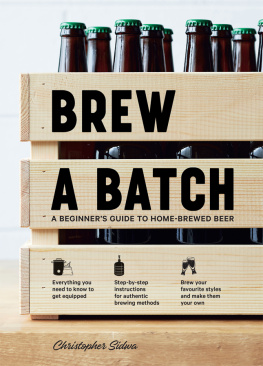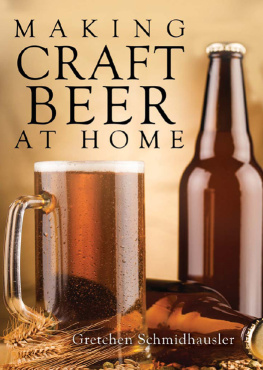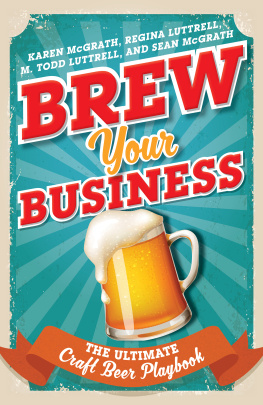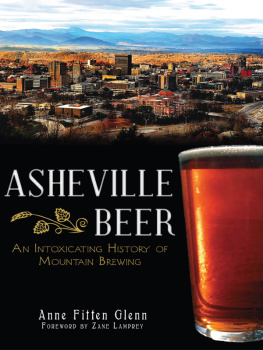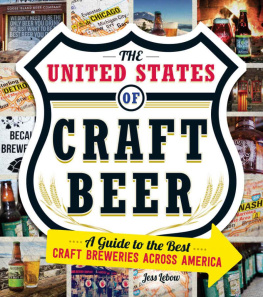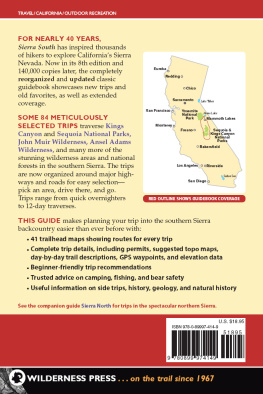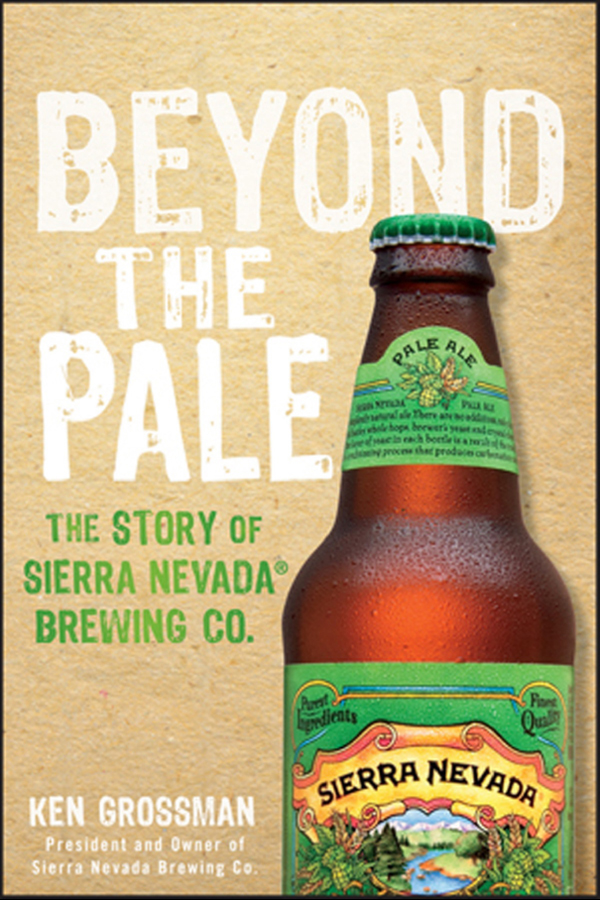CONTENTS

Cover image: (Bottle and Hops) Courtesy of Author
Cover design: Mike J. Freeland
Copyright 2013 by Sierra Nevada Brewing Co. All rights reserved.
Published by John Wiley & Sons, Inc., Hoboken, New Jersey.
Published simultaneously in Canada.
No part of this publication may be reproduced, stored in a retrieval system, or transmitted in any form or by any means, electronic, mechanical, photocopying, recording, scanning, or otherwise, except as permitted under Section 107 or 108 of the 1976 United States Copyright Act, without either the prior written permission of the Publisher, or authorization through payment of the appropriate per-copy fee to the Copyright Clearance Center, 222 Rosewood Drive, Danvers, MA 01923, (978) 750-8400, fax (978) 646-8600, or on the web at www.copyright.com . Requests to the Publisher for permission should be addressed to the Permissions Department, John Wiley & Sons, Inc., 111 River Street, Hoboken, NJ 07030, (201) 748-6011, fax (201) 748-6008, or online at www.wiley.com/go/permissions .
Limit of Liability/Disclaimer of Warranty: While the publisher and author have used their best efforts in preparing this book, they make no representations or warranties with the respect to the accuracy or completeness of the contents of this book and specifically disclaim any implied warranties of merchantability or fitness for a particular purpose. No warranty may be created or extended by sales representatives or written sales materials. The advice and strategies contained herein may not be suitable for your situation. You should consult with a professional where appropriate. Neither the publisher nor the author shall be liable for damages arising herefrom.
For general information about our other products and services, please contact our Customer Care Department within the United States at (800) 762-2974, outside the United States at (317) 572-3993 or fax (317) 572-4002.
Wiley publishes in a variety of print and electronic formats and by print-on-demand. Some material included with standard print versions of this book may not be included in e-books or in print-on-demand. If this book refers to media such as a CD or DVD that is not included in the version you purchased, you may download this material at http://booksupport.wiley.com . For more information about Wiley products, visit www.wiley.com .
Library of Congress Cataloging-in-Publication Data:
Grossman, Ken, 1954
Beyond the Pale: The Story of Sierra Nevada Brewing Co./Ken Grossman.
Includes index.
ISBN: 978-1-118-00736-5 (cloth); ISBN: 978-1-118-22188-4 (ebk);
ISBN: 978-1-118-23557-7 (ebk)
1. Sierra Nevada Brewing Co. 2. Brewing industryCaliforniaHistory.3. Beer industryCaliforniaHistory 4. Grossman, Ken, 1954- 5. BrewersCaliforniaBiography. I. Title.
HD9397.U54
338.766342092dc23
[B]
2013020065
PREFACE
In 2009, I was first approached by my friend and colleague Sam Calagione, founder of Dogfish Head Brewery, about being involved in a book on the dawn of American craft brewing. Sam planned on doing several long, in-depth interviews with a handful of brewers to try to capture what it was like during the early years before many people accepted or even knew what craft beer or being a craft brewer was all about. The marketplace was so different than it is today, and its hard for many beer drinkers who grew up with craft beer to imagine a time when there were virtually no options other than American light lagers and a few almost indistinguishable imported lagers.
I was enthusiastically but cautiously on board and welcomed the opportunity to revisit those early years of building Sierra Nevada Brewing Co. and tell my story. Over the years several people had tried to convince me to write my own book, but I never felt I had time and put it off. When Sam asked, my time was already pretty well committed, as usual, but it seemed worthwhile. I thought I could fit it into my busy schedule since he would be doing most of the work. Sam had already written two beer books, and I thought he had the desire and energy to dig in to the story.
In the past few years, there have been several accurate and well-researched publications that have done a good job touching on the early pioneers of craft brewing and the industrys rapid growth over the past 30 years, as well as giving a good overview of the wider beer industry. Maureen Ogles Ambitious Brew , Tom Acitellis The Audacity of Hops , and Steve Hindy and Tom Potters Beer School give readers an inside look at the craft industry. Even so, theres a lot that hasnt been written about the amazing American beer revolution that has spawned an unprecedented consumer movement and that has now spread globally with US-inspired craft breweries opening in dozens of countries around the world.
Sam planned to write a more focused book with just the handful of brewers who took a big leap of faith and decided to get into the brewing business when, based on all accounts, the odds were heavily stacked against them. He was going to start with the first generation of homebrewers who went pro in the late 1970s and early 1980s. Charlie Papazians participation would weave in the role that homebrewing played and the establishment of the Association of Brewers, which became the current Brewers Association.
When Sierra Nevada took that leap, the American brewing industry had hit bottom, with scarcely 40 individual brewing companies in existence. The industry had hit a high of more than 3,000 breweries in the 1870s but declined after that as a result of Prohibition, the repeal of Prohibition, and other forces. The few small breweries that remained in the 1970s were unable to compete with a handful of aggressive national brands that capitalized on economies of scale both in lower production costs and in their ability to leverage syndicated radio, and later TV, to promote their increasingly homogenous light lagers. Most of the surviving small brewers tried to match the style and price of national brands, but with declining volumes and, in most cases, deteriorating pre-Prohibition plants, they couldnt remain competitive or sustain their companies.
Sam intended to focus on the small group of brewers who were the first to reverse that trend. In the late 1970s there were half a dozen of us who made the jump from homebrewing to establishing the first crop of micro, or craft, breweries in America. Most people in the brewing industry thought we were nuts, and the rate of brewery consolidation had some analysts predicting that there would be only two or three breweries that survived into the future. People wondered what we were thinking, opening breweries when so many had failed so recently. Even many of my closest family members and friends werent sure it was such a great idea, but I persisted with my vision for Sierra Nevada.
I cant speak for everyone in that early group, but I think most of us had a similar vision. We wanted to make a different kind of beer; we didnt want to make what the other breweries were brewing. In most parts of the country, there really wasnt any interesting American beer on the shelves, and the majority of what you could find was light lager. As accomplished homebrewers we wanted to brew the types of beer we had grown to love, and we wanted to share our beer , our hoppy, dark, flavorful creations. Our friends loved our beers; certainly we could find other people who would as well. We all had modest ambitions and severely limited budgets. All of us borrowed and begged money from family and friends because no institution would loan us a penny. We cobbled together our breweries with used parts, resourcefulness, and ingenuity and proceeded to brew the beers we loved. At the time, what we were doing certainly didnt seem to be a movement and definitely didnt seem to be one that would grow for more than 30 years to become what it is today.


